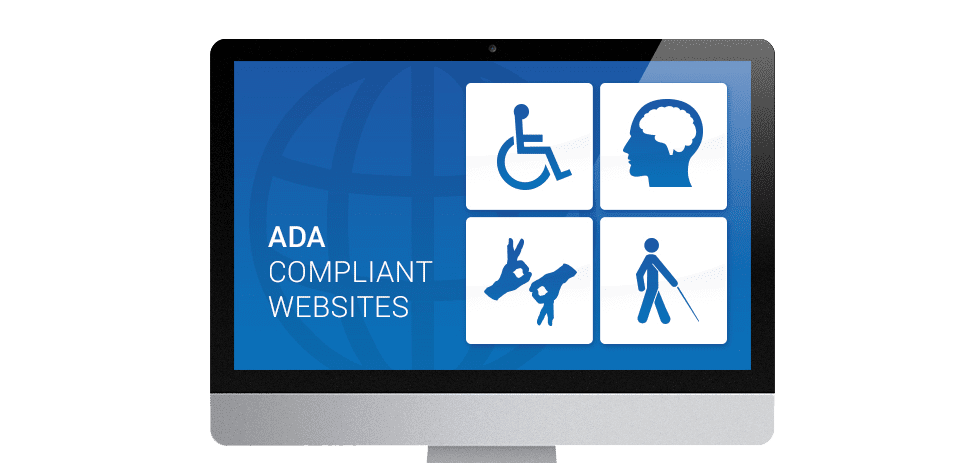
The Americans with Disabilities Act (ADA), established in 1990, prohibits discrimination against people with disabilities, ensuring accessible public services and businesses. The U.S. Department of Justice (DOJ) enforces the ADA and proposes incorporating web accessibility standards like WCAG 2.0. This ensures websites are accessible, preventing barriers for over 60 million Americans with disabilities. Compliance is crucial for legal adherence and inclusive online engagement, affecting both physical and digital services. Current guidelines are evolving, but businesses must address web accessibility now to avoid exclusion and potential legal issues.
The Americans with Disabilities Act (ADA), signed into law in 1990, prevents discrimination against a group that has historically faced many barriers. The ADA makes it illegal in this country for any government or business to provide goods and services to the public that are not also accessible to people who have disabilities.
In many situations, however, it can be challenging to establish just what is meant by accessible. That’s why the U.S. Department of Justice (DOJ), which enforces the ADA, has issued a Supplemental Advanced Notice of Proposed Rulemaking (SANPRM) to incorporate web accessibility into the standards. Organizations are encouraged to use the WCAG 2.0 level AA technical requirements as a guide for digital accessibility.
The DOJ’s public position was clarified in the following statement made during the Netflix case:
“The Department is currently developing regulations specifically addressing the accessibility of goods and services offered via the web by entities covered by the ADA. The fact that the regulatory process is not yet complete in no way indicates that web services are not already covered by title III.”
These ADA guidelines for web accessibility are an important and useful reference. But they may also evolve over time, so it’s important to stay up to date on the recommendations that are most relevant to your organization.
Organizations Covered Under the ADA

A wide range of agencies and companies are covered under the ADA. This includes state and local governments (Title II regulations), and what are termed “public accommodations” (Title III regulations) – which are, essentially, any business or non-profit organization that serves the public. Title III covers a lot of ground, including restaurants, theaters and schools, ensuring that individuals cannot be denied entry to these places, or denied service by these companies, solely based on a disability. This includes services that are provided through a website or other digital format.
The reasoning is that if other people can file tax returns online, or apply for a job through an employment website, or place a product order outside of regular business hours, then it’s unfair to have barriers in place that make it impossible for people with disabilities to do these very same things. It’s especially unjust when the know-how to do away with these barriers already exists. That’s where the ADA guidelines come in, helping to ensure those barriers are eliminated.
Why Web Accessibility Makes a Difference
It’s become routine for government departments, businesses and organizations to connect with customers, clients and residents online. It also drives ecommerce. Invesp, a conversion optimization firm projects that in 2018 almost 9% of all retail spending in the U.S.1 – the highest this number has ever been – will take place online.
If a website isn’t accessible then it’s excluding over 60 million Americans with disabilities.
The Click-Away Pound survey2, a collaboration of several groups including the Business Disability Forum, demonstrated that in the United Kingdom alone, retailers lost £11.75 billion (over $15 billion U.S.) last year because of inaccessible websites.
Over 71% of customers will leave a website that doesn’t meet their accessibility needs. On the flip side, four out of five customers with disabilities would spend more if a website’s accessibility was improved.
According to ADA regulations3, it is acceptable for an organization with an inaccessible website to provide an alternative method of accommodating people with disabilities, just as long as this alternative delivers an equal level of service. In today’s digitally-driven world this would be difficult to achieve, considering that websites are available at any time of day or night, and from virtually anywhere, since all that’s needed is an Internet connection. The alternative for people with disabilities would also need to be open for business around the clock, and be available regardless of whether the person is sitting at home or sitting on a park bench.
It’s much simpler, and considerably less costly, to improve web accessibility for all. A website that follows accessibility guidelines and is barrier-free also tells customers with disabilities that they’re valued, and their business is welcome.
ADA Proposed Requirements for Online Accessibility
As we mentioned earlier, the Department of Justice offers guidelines to help organizations and governments ensure accessibility in various areas. For example, it issued the “ADA Standards for Accessible Design” to explain features of physical spaces, such as entrances and elevator buttons. Its “ADA Checklist for Polling Places” provides information on how to ensure that voters with disabilities are fully accommodated.
There are also ADA recommendations for web accessibility. The “ADA Best Practices Tool Kit4,” produced by the Department of Justice to help state and local government agencies make their websites accessible, includes a chapter on website accessibility. Along with this chapter is a checklist to help administrators identify some of the most common digital barriers, such as inaccessible online forms and tables.
In many ways, these ADA guidelines are useful. They explain how various disabilities can affect the way people interact with websites, and why certain barriers can prevent these individuals from using a website. They can give administrators a preliminary sense of how accessible their current site is. Although these guides were written for entities covered under Title II of the ADA (state and local governments), they’re also relevant for organizations covered under Title III, who are encouraged to meet the same requirement for web accessibility.
Limitations of Current ADA Guidelines
These suggested guidelines, unfortunately, are not exhaustive. They only provide direction on some of the most common accessibility problems, not all of them. They don’t give detailed technical instructions.
In the meantime, the Department of Justice is working on a final release of technical standards for web accessibility. These new ADA standards would be written for organizations covered under Title III. The intention is to harmonize them to the the Web Content Accessibility Guidelines WCAG 2.0, which are the most widely accepted web accessibility requirements in the world.
The ADA standards for web accessibility may not be finalized for some time yet. However, it doesn’t mean companies aren’t required to remove barriers from their websites right now. The Department of Justice routinely refers to WCAG 2.0 as the current guidelines to follow for digital accessibility.
The Department of Justice Enforces Web Accessibility
Although the Internet as we know it didn’t exist when the ADA was first written, it’s quite clear that this law applies to web accessibility. “Being unable to access websites puts individuals with disabilities at a great disadvantage in today’s society,” the Department of Justice has written5. It points out that many education programs and networking opportunities are provided online, and that being able to make purchases online often results in cost-savings for the consumer – not to mention a greater convenience. People with disabilities have a right to equal access to these benefits.
The department adds that equal opportunity for people with disabilities can be achieved only if businesses understand that web accessibility is an obligation under the ADA. When you consider the added value of providing digital accessibility to your clients and customers, this is one obligation that you should be hastening to meet.
The above information comes directly from “Essential Accessibility“


